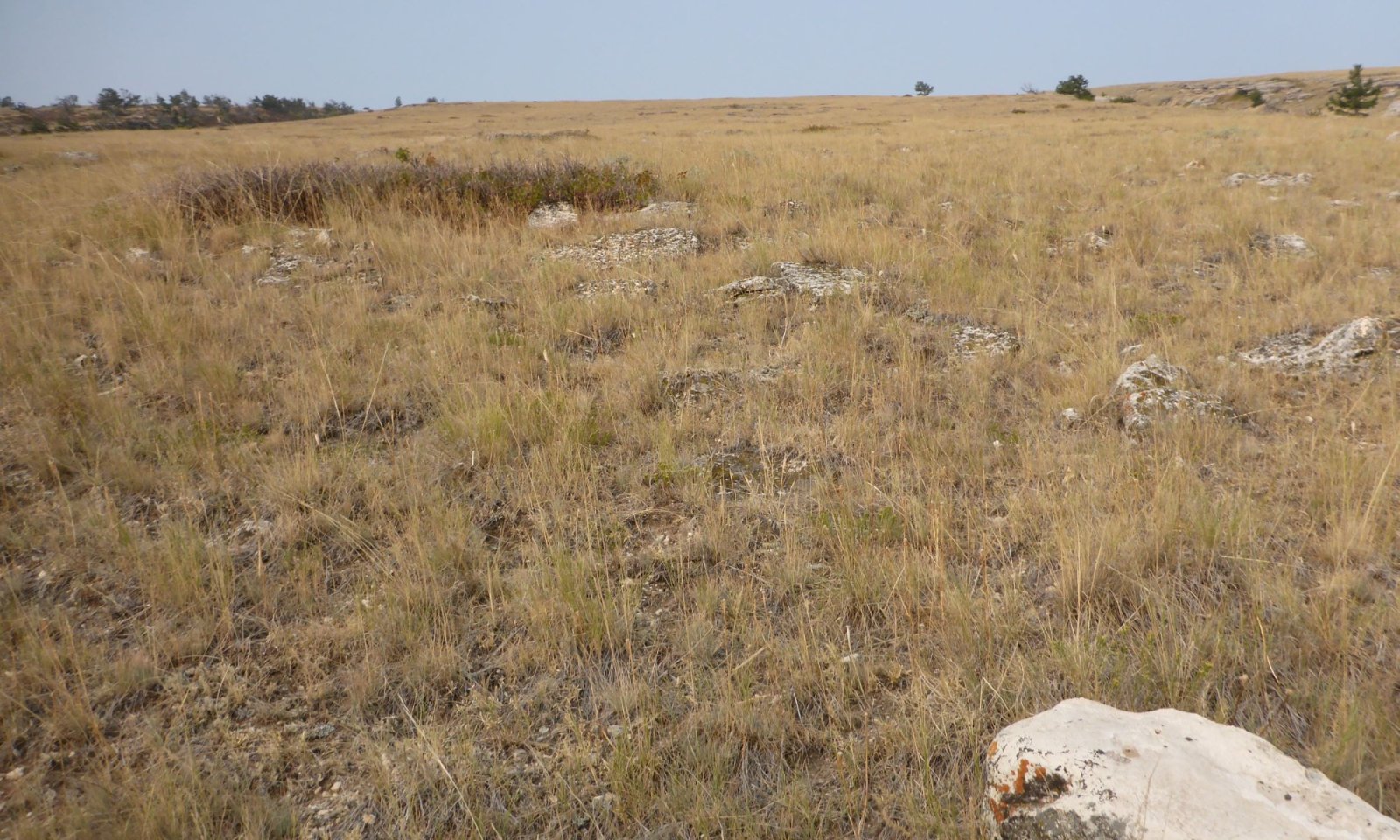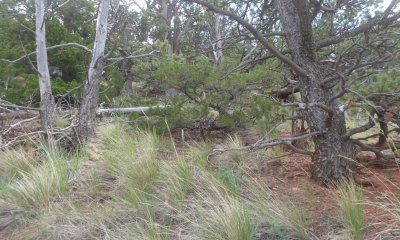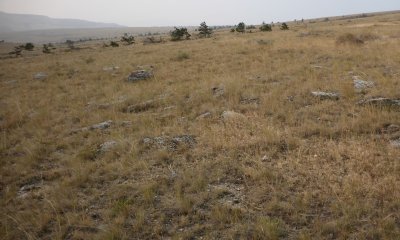
Channery Upland (CnU) Absaroka Upper Foothills
Scenario model
Current ecosystem state
Select a state
Management practices/drivers
Select a transition or restoration pathway
-
Transition T1A
Lack of fire, weakened herbaceous cover, and aspect can have an influence on the encroachment or increase of tree cover.
More details -
Transition T1B
Disturbance to the soil surface provides the opportunity for invasive species to find their niche in a community.
More details -
Restoration pathway R2A
Fire or tree control, followed by a period of recover, and potentially seeding will allow this community to improve.
More details -
Transition T2A
Fire or lack of fire, drought with or without hoof impact or mechanical soil impact to displace the understory species, opens the niche for invasive species to encroach and establish.
More details -
Restoration pathway R3A
Integrated weed management, seeding and grazing management will establish a targeted community.
More details -
Transition T4A
Any disturbance to or failure in reclaiming the community leaves this State at risk to invasion.
More details -
No transition or restoration pathway between the selected states has been described
Target ecosystem state
Select a state
State 1
Perennial Grasses/Mixed Shrubs



Description
The reference state (State 1) for the Channery Upland ecological site is dominated by tall-stature, cool-season bunchgrasses. This State persisted under areas that were grazing by large ungulates, however there is limited access by livestock. The associated rock uplifts and steeper slopes provides a forage resource and habitat for a variety of wildlife.
Characteristics and indicators
The Perennial Grasses/Mixed Shrubs State (State 1 Reference) is characterized by the prominent cover of Columbia needlegrass, Idaho fescue, spike fescue, and bluebunch wheatgrass (15-30 percent composition). Rhizomatous wheatgrasses and prairie Junegrass are common, with 10 percent or less cover of shrubs including Mountain big sagebrush. Minor components to the overall composition is made up of Sandberg bluegrass, bottlebrush squirreltail, and threadleaf sedge.
Resilience management
This state occurs in areas that are grazed moderately with periods of rest by large ungulates including livestock (cattle and sheep), as well as antelope, deer, and elk. Prescribed grazing and drought planning allows this State to persist. The community is adaptable to drought with management.
Submodel
State 2
Tree Dominated



Description
Limber pine and Rocky Mountain juniper cover is common on the Channery Upland ecological site, in trace amounts (less than five percent cover). On certain aspects or when climatic conditions are slightly altered, the tree cover will increase in the absence of fire. A weakened herbaceous cover provides the opportunity for the trees to establish and become dominant.
Characteristics and indicators
The key indicator of becoming tree dominated, is the presence of tree cover in greater than 15 percent cover. The composition includes a productive (although limited) understory of grasses with minor cover of shrubs and forbs.
Resilience management
The lack of fine fuels with a decreased herbaceous cover, and a crown cover that is relatively open, providing a low fire threat. This State is resistant to change in the absence of fire. Grazing pressure will have an impact on the understory, but has minimal effect on the woody cover. If the community is impacted by fire or other disturbances, it holds a low resilience.
Submodel
Description
The Invaded State has a range of variability that is distinguished by its population of invasive or introduced (non-native) species that has successfully established and is significant within the composition of the community.
Characteristics and indicators
The threshold for invasive species within the community (composition by weight) is five percent or greater to transition a community into the Invaded State. The community can be relatively intact, having a representative composition of native species similar to the Reference State, but with a significant composition (minimum of five percent) cover of an invasive species or mix of invasive species. Cheatgrass is the most significant threat at this time; however, there are other aggressive non-native species that pose a concern on this ecological site. Non-native species such as smooth brome, Kentucky bluegrass, and native species such as Rocky Mountain juniper encroach into this community.
Resilience management
The competitive edge of most invasive species makes this site resistant to change and resilient following disturbance. Cheatgrass has been seen to respond with a positive potential following disturbances (fire, mechanical). Management of smooth brome and Kentucky bluegrass pose a challenge, but do provide a grazing resource. Rocky Mountain juniper is a natural part of the community, but with shift of disturbance regimes, does become an aggressive species that can be controlled and reduced in the community.
Submodel
Description
Disturbance to these highly erodible soils (whether it was mechanical, cultural, or natural) removes the resiliency of the native vegetation. Changes to soil structure and hydrologic processes reduce the stability and ability to recover. Reclamation or restoration of an area is limited or restrictive due to slope, access, and extent of rock fragments on and in the soil profile.
One catastrophic event or several smaller disturbances can lead to the transition to the Altered State from any state within the State-and-Transition Model. The soils have not been altered to the extent that they are outside the site characteristics, but the potential has shifted enough that it will not respond like the Reference State.
The time required to allow the redevelopment of structure is beyond the natural function of management. The initial flush of vegetation is annual forbs and sub-shrubs. This successional plant community allows the site to begin recovery, but the time required to return to the original conditions (pre-disturbance) can be extensive.
Characteristics and indicators
The Altered State is characterized by an area that has had significant soil disturbance. Early successional plant communities, evidence of mining, or the presence of introduced species (crested wheatgrasses, Russian wildrye, etc.) are indicators of this State.
Resilience management
Stabilization and preservation of as much soil as possible is the mechanism to provide resiliency to this State. The use of mulch or other slope stabilization materials will help in reducing erosional impact and allowing vegetation to establish.
Submodel
Mechanism
The transition to a tree dominant state requires more consideration and analysis. It is known to be a factor of temperature an effective moisture, encouraging higher rates of establishment on the landscape. North and east aspects that are still within the frigid temperature range but with higher relative effective precipitation have a higher potential for tree establishment. In areas that are more southerly favors juniper encroachment in the absence of a strong herbaceous cover. Grazing pressure, wildlife movement, especially bird activity, and lack of fire attribute to the ability for trees to increase in density and vigor.
Constraints to recovery
The lack of fine fuels and canopy closer to easily carry fire, the aggressive nature of Rocky Mountain Juniper, and slope coupled with the lack of key herbaceous species are the major constraints to recovery.
Mechanism
Drought, soil disturbances, or high-intensity grazing with a seed source present can open the soil surface and help encourage invasive species to establish. Although not common, fire can provide the niche for cheatgrass to establish on this site. The movement of wildlife as well as livestock through the landscape is also a way that seeds sources are introduced to the community.
Constraints to recovery
Once invasive species, especially cheatgrass, establish, it is costly and difficult (if even possible) to remove. Slope, rock fragment content as well as access due to landforms, limit the ability and means of invasive control. This also can be a limitation or constraint to recovery for this community. The lack of the key grass species may be a minor limit to recover of this site.
Mechanism
Impacts to the sod cover followed by a period of recovery can allow mid-stature and short-stature native grasses to gain a better hold in this community to improve. Recovery is dependent on the remnant population of herbaceous species that are present, the current weather patterns, and timing. The use of mechanical means or high impact hoof action can also help with breaking up the dominance of the sod to allow native to establish. The use of seeding will assist with recover as well.
Relevant conservation practices
| Practice | External resources |
|---|---|
|
Brush Management |
|
|
Prescribed Burning |
|
|
Critical Area Planting |
|
|
Prescribed Grazing |
|
|
Grazing Land Mechanical Treatment |
|
|
Range Planting |
|
|
Integrated Pest Management (IPM) |
|
|
Upland Wildlife Habitat Management |
|
|
Forest Stand Improvement |
Mechanism
Fire, drought or insect degradation, soil disturbances, or grazing with a seed source present can open the soil surface and weaken the understory cover allowing invasive species to establish. Fire can provide the niche for cheatgrass to establish on this site, while a lack of fire with juniper present can encourage juniper encroachment and cheatgrass to establish with the loss of other understory species. Use and movement of wildlife through the community as well as livestock are a source of invasive species.
Constraints to recovery
Once invasive species, especially cheatgrass, establish, it is costly and difficult (if even possible) to remove. The lack of the key grass species also limits recovery of this site.
Context dependence
In the instances where Rocky Mountain juniper is considered an invasive species, juniper control provides a greater potential for control and site improvement. But management considerations may shift depending on extent of encroachment and community shift.
Mechanism
Integrated Pest Management, with seeding the site to a native mixture, or a targeted set of select species, assist the restoration of this community. Success is not known to have occurred, and is rated to be low and highly variable for the rate of control of most species. Cheatgrass is one of the most invasive species for many ecological sites, although there are other challenges. With intensive weed control and inputs this community can resemble an at-risk community within the reference state, but it is not possible to reach the reference community condition once annuals have established.
Context dependence
The specific invasive species that is established in the community, the state of the native species that are present and the accessibility of the site is determinate on the ability to achieve or attempt restoration of an invaded community.
Relevant conservation practices
| Practice | External resources |
|---|---|
|
Prescribed Burning |
|
|
Critical Area Planting |
|
|
Prescribed Grazing |
|
|
Grazing Land Mechanical Treatment |
|
|
Heavy Use Area Protection |
|
|
Integrated Pest Management (IPM) |
|
|
Upland Wildlife Habitat Management |
|
|
Forest Stand Improvement |
|
|
Native Plant Community Restoration and Management |
Mechanism
Frequent or Severe Grazing, Disturbance with a seed Source, or Drought - Any disturbance that occurs or stress that is placed on the herbaceous cover, weakens the canopy and allows for invasive species to establish if a seed source is present. This State is at high risk of transitioning to an Invaded State. The limited abilities to complete a seeding on rocky soil opens the community to invasion.
Constraints to recovery
The challenge of eradicating or reducing invasive species such as cheatgrass prevents recovery of most invaded communities without significant inputs for weed control, seeding with long-term grazing management.
Model keys
Briefcase
Add ecological sites and Major Land Resource Areas to your briefcase by clicking on the briefcase (![]() ) icon wherever it occurs. Drag and drop items to reorder. Cookies are used to store briefcase items between browsing sessions. Because of this, the number of items that can be added to your briefcase is limited, and briefcase items added on one device and browser cannot be accessed from another device or browser. Users who do not wish to place cookies on their devices should not use the briefcase tool. Briefcase cookies serve no other purpose than described here and are deleted whenever browsing history is cleared.
) icon wherever it occurs. Drag and drop items to reorder. Cookies are used to store briefcase items between browsing sessions. Because of this, the number of items that can be added to your briefcase is limited, and briefcase items added on one device and browser cannot be accessed from another device or browser. Users who do not wish to place cookies on their devices should not use the briefcase tool. Briefcase cookies serve no other purpose than described here and are deleted whenever browsing history is cleared.
Ecological sites
Major Land Resource Areas
The Ecosystem Dynamics Interpretive Tool is an information system framework developed by the USDA-ARS Jornada Experimental Range, USDA Natural Resources Conservation Service, and New Mexico State University.



